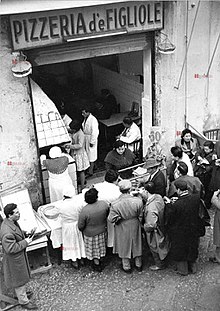Pizza Margherita or Margherita pizza[1] is a typical Neapolitan pizza, roundish in shape with a raised edge (the cornicione) and garnished with hand-crushed peeled tomatoes, mozzarella (buffalo mozzarella or fior di latte), fresh basil leaves, and extra virgin olive oil.[2] The dough is made by mixing water, salt and yeast (sourdough, fresh or dry brewer's yeast) with flour (00 or 0).[2]
 | |
| Alternative names | Margherita pizza |
|---|---|
| Type | Pizza |
| Place of origin | Naples |
| Region or state | Italy |
| Created by | Raffaele Esposito |
| Invented | 1889 |
| Main ingredients | Canned tomatoes, mozzarella, basil, extra virgin olive oil |


Traditionally, the dough is stretched by the pizzaiolo in a motion going outwards from the center, pressing with the fingers of both hands on the dough ball, and flipping it several times, shaping it into a disc.[2] Thereafter, it is topped and baked in an oven, which is traditionally made of brick and wood-fired (electric or gas ovens are also used nowadays).[3] Pizza Margherita is usually served hot on a plate or folded into four and wrapped in paper (pizza a portafoglio or a libretto).[4][5]
History

A popular contemporary legend holds that the archetypal pizza Margherita was invented in June 1889, when the Royal Palace of Capodimonte commissioned the Neapolitan pizzaiolo (lit. 'pizza maker') Raffaele Esposito to create a pizza in honor of the visiting Queen Margherita. Of the three different pizzas he created, the Queen strongly preferred a pizza swathed in the colors of the Italian flag — red (tomato), green (basil), and white (mozzarella).[6] Supposedly, this kind of pizza was then named after the Queen,[7] with an official letter of recognition from the Queen's "head of service" remaining to this day on display in Esposito's shop, now called the Pizzeria Brandi.[8] Later research cast doubt on this legend, undermining the authenticity of the letter of recognition, pointing that no media of the period reported about supposed visit and that both the story and name Margherita were first promoted in the 1930s–1940s.[9][10]
The origins of pizza Margherita came from mixing similar toppings that were already present in Naples between 1796 and 1810.[11] In 1849 Emanuele Rocco recorded different pizza toppings including basil, tomatoes and thin slices of mozzarella;[12] the mozzarella was thinly sliced, and added to the toppings already present.
In 1866, Francesco De Bourcard, writing about the Naples traditions,[12] described the most commonly used pizza toppings at that time as well as the possible origin of calzone:
The most ordinary pizza, called coll'aglio e l'olio (lit. 'with garlic and oil'), is dressed with oil, and over it is spread, as well as salt, origanum and garlic cloves shredded minutely (optionally). Others can be covered in grated cheese and dressed with lard, and then they put on a few leaves of basil. Over the former is often added (depending on the region) some small seafish; on the latter some thin slices of mozzarella. Sometimes they use slices of prosciutto, tomato, arselle, etc. Sometimes folding the dough over itself to form what is called calzone.[12]
Gallery
- Traditional Neapolitan Margherita pizza







